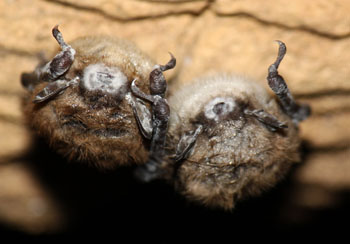
White-nose syndrome (WNS) is an infectious disease associated with a fungus (Pseudogymnoascus destructans) responsible for unprecedented levels of mortality among hibernating bats in North America. WNS is named for the white fungal growth on the skin of the muzzle, wings, and ears of cave-dwelling bats during winter hibernation. The disease was first noted in New York in 2006 and has since spread to 40 states and eight Canadian provinces. The fungus that causes WNS has been found in three additional states and two Canadian provinces. Twelve different bat species, including two federally endangered species and one threatened species, have been affected by WNS. As of 2011, the disease has caused the death of an estimated 5.7 to 6.7 million bats across eastern North America, with estimates of mortality often exceeding 90% in infected caves.
Progression of WNS in Indiana
- WNS was first detected in Indiana in January 2011 during routine winter hibernacula surveys conducted by Division of Fish & Wildlife bat biologists.
- By the end of that first winter, the disease had been found in six caves in Crawford, Monroe and Washington counties.
- During the following winter, bats exhibiting sign of WNS infection were observed in or reported from 20 additional caves that included six new counties (Greene, Harrison, Jefferson, Lawrence, Martin and Orange).
- Disease surveillance during the 2012-13 winter resulted in WNS detection from nine more caves that included one new county (Jennings).
- Two caves and one new county (Vermillion) were added from WNS surveillance during the 2013-14 winter.
- One cave in Jefferson County was added during the 2014-15 winter.
- WNS is widely distributed throughout much of the karst region in south-central Indiana and locally established within most of the state’s major concentrations of important bat hibernacula.
Impacts of WNS on Wintering Bats in Indiana
For nearly 30 years, Wildlife Diversity biologists in Indiana have conducted population counts of hibernating bats every other winter. This biennial schedule minimizes disturbance but still provides important information needed to monitor the status and health of the state’s bat populations. At present, there are 21 WNS-affected hibernacula in Indiana that have long-term winter bat population counts. The impact of WNS can be assessed by comparing the last count before the disease was detected in a particular site (2009) to its most recent count (2017-2018; no sampling was done in 2020). In these sites, the total population of all species combined has dropped from about 220,315 bats in the latest pre-WNS winter to 182,306 in the most recent post-WNS winter, a decline of about 17 percent. The impact of the disease, however, appears to differ by species. Using the same approach, biologists have tallied the following numbers for Indiana’s most common winter bat species:
little brown bats: 89% decline
from 6,873 in latest pre-WNS winter to 743 in most recent post-WNS winter.
tri-colored bats: 91% decline
from 1,163 in latest pre-WNS winter to 100 in most recent post-WNS winter.
big brown bats: 47% decline
from 238 in latest pre-WNS winter to 125 in most recent post-WNS winter.
Indiana bats: 15% decline
from 212,041 in latest pre-WNS winter to 181,338 in most recent post-WNS winter.
Status of WNS
For more information on WNS:
Public Access to Indiana DNR-owned Caves
In response to a growing concern for bat populations affected by WNS in Indiana, the Indiana Department of Natural Resources (IDNR) closed public access to caves, sinkholes, tunnels and abandoned mines on IDNR-owned land in 2009. This action, made in consultation with the U.S. Fish and Wildlife Service, was a preemptive step in an attempt to slow the spread of the deadly fungus that causes WNS. The fungus can be transported from cave to cave on the boots and clothing of people, as well as by bats.
In 2014, the Indiana DNR initiated a pilot program to allow limited access to select caves at Spring Mill State Park and Cave River Valley Natural Area. The program, in partnership with the Indiana Karst Conservancy (IKC), allows for recreational caving during the summer beginning in May 2014. Groups wishing to gain access to select caves in Spring Mill State Park or Cave River Valley Natural Area must apply for a permit and comply with proper WNS decontamination protocols. Groups must register in advance through the IKC and complete an online training module that explains decontamination procedures to prevent the spread of WNS to other caves and states. To learn more about the interim cave access program click here.
Indiana Nongame Wildlife Fund
Funding for WNS monitoring in Indiana is funded, in part, by citizen donations to the Indiana Nongame Wildlife Fund. To support this project and others like it, visit our donate page.
